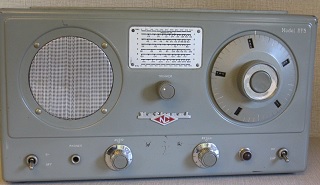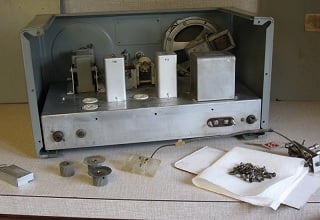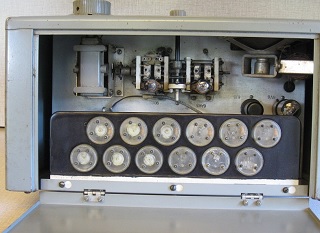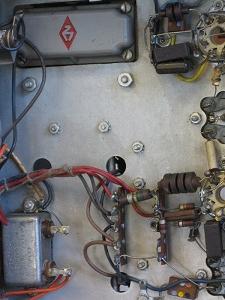Vintage Audio: National Radio NC-HFS VHF Receiver | Telos Alliance
By The Telos Alliance Team on Jul 13, 2015 5:03:11 PM
 Vintage Audio: National Radio NC-HFS VHF Receiver
Vintage Audio: National Radio NC-HFS VHF Receiver
During a recent Found in the Attic we visited Malden, Massachusetts while discussing the Millen 90651 grid-dip meter. Malden was also the home of National Radio Company. It occurred that after about 25 installments of FitA, no NRC equipment has ever been hauled down from the great upstairs for a write-up. Easy to remedy. The only challenge was finding something a bit unusual. Almost hidden behind a stack of National shortwave receivers was a 1949 NC-HFS VHF radio. Yes, that will do.
National was a pioneer in developing VHF communications technology, starting in the early 1930s. One of their first offerings was the SRR (SuperRegenerative Receiver). It came with coils for the 5-meter amateur band, but additional coils could be purchased for the HF bands. The selling point for a super regenerative circuit was its very high sensitivity.
As VHF technology progressed, National introduced the model 1-10 in 1938, followed by the 1-10A. These receivers also had super-regenerative circuits, and were shipped with coils covering 27 to 290 MHz. Both had the PW-D dial, and the detector and RF oscillator circuits were designed around acorn tubes - pretty cutting-edge stuff at the time. The 1-10A was in production through 1949, when the NC-HFS was introduced.
The National HFS covers all frequencies from 27 to 250 MHz. It's a 7-tube superheterodyne-super regenerative receiver-converter that can receive AM, FM (via slope detection), and CW signals. The receiving range is divided into six bands, each with two plug-in RF coils.
In the high frequency converter mode, the HFS is used by connecting the 10.7 Mhz IF output to the antenna input of a communications receiver tuned to 10.7 Mhz. Some enhancement in performance is possible in the converter mode, because in most cases, the SW receiver will be more selective than the HFS.
The regeneration control adjusts the plate voltage on the second detector to provide regeneration or super regeneration. The super regenerative condition, normally used for phone reception, provides excellent AVC and noise limiting action. The regenerative non-oscillating condition takes place at dial settings from 0 to 3; the regenerative oscillating condition between 3 and 4; and super regenerative condition occurs between 4 and 10.
In 1949, the HFS sold for $125, less the external power supply, which was $22.00 extra.
The use of an external power supply was intended to give the receiver more flexibility. It could be used with external batteries for remote work, with an external vibrator power supply for mobile applications, or with a conventional supply for AC power.
This particular HFS was found curbside during an annual spring cleanup day in the late 1980s. It was missing the external power supply, and looked like it had been stored in a damp basement for many years. The original 4-conductor power cable and connector had been replaced by a short length of quad phone wire. After a cursory examination, it was stashed in the attic, its fate TBD.
The HFS manual was downloaded from the BAMA website, and a quick cosmetic cleanup began. But it wasn't long before it was 1:30 AM and the HFS had been completely disassembled on the kitchen counter. Clearly, this was done because your editor does not have enough on his plate already. During this major teardown and cleaning, a serious problem with the HFS began to surface.
Once the Plexiglas covers on the coil sockets were removed, it was discovered that the turret for one of the sockets was missing completely, and a pin on the other socket was badly bent. On two of the others, the springs were poking out. All of the springs were badly rusted, and the sockets themselves were dirty and corroded.
The socket issues are a big problem because these items are made of unobtainium. Perhaps this is why the HFS was left curbside.
Possibly the coil sockets were a weak point in the design of this receiver. Or maybe the previous owner was heavy handed and broke them. They could have just worn out after years of hard use. No matter. The challenge is how to fabricate replacements from scratch.
The HFS received a more thorough cleaning and overhaul than expected. All switches and contacts were cleaned, tubes were checked, and few bad components were replaced. Hardware was soaked in WD-40 and cleaned. Next, a power cable and connector need to be fabricated, a power supply needs to be built, and of course, those coil sock ets need to be made. Something involving brass tubing from the hobby shop and pins from a cannibalized tube socket comes to mind. In the meantime, the HFS looks great, and will be put on display.
ets need to be made. Something involving brass tubing from the hobby shop and pins from a cannibalized tube socket comes to mind. In the meantime, the HFS looks great, and will be put on display.
No discussion of National gear or its restoration is complete without mention of the PW-D micrometer dial, colloquially known as the HRO dial. Before the days of frequency synthesis and digital readouts, the only way to get razor-sharp tuning accuracy was through precision mechanical engineering. The PW-D dial and associated 20-to-1 vernier gearbox, introduced by National in 1934, was as good as it gets. The combination gives an effective scale length of 12 feet, and gave a resolution of 1 part in 500. Ten turns moves the tuning capacitor from stop to stop. The PW-D was designed by the legendary James Millen.
It was used in the original HRO receiver, and on many premium National sets right up to the company's last offering in 1965, the HRO 500. The dial and reduction gear assemblies were also sold as individual parts, which were widely used by radio amateurs who built their own equipment.
The expansive vernier action comes from the gear drive, either the model PW (right angle), or NPW (straight through). The gearing built into the knob only drives the numbers visible in the five windows around the dial. Both gearboxes feature spring-loaded gears to eliminate backlash as the mechanism wears.
There are some mechanical devices that are fun to take apart and restore. The PW-D dial is not one of them. If you are restoring a National receiver, and the dial works smoothly, count your blessings and leave it alone. If the dial binds or has backlash, there are several resources on the web describing how to make it well. It is advisable to consult one of these before taking the dial apart.
National had its origins in 1914, but not as an electronics manufacturer. The company was originally focused on toys, and later expanded to the manufacture of household goods. The name was changed from National Toy Company to National Company to reflect this expanded product line.
In the mid-1920s, National was heavily involved in the production of capacitors for the booming radio receiver industry. They were approached by two engineers from Harvard University, Fred H. Drake and Glenn Browning. They wanted National to build components for a radio receiver of their own design. This partnership led to the production of the National Regenaformer, one of the first radio kits. The Regenaformer could only receive AM signals, but it was the beginning of National's transition to a full-time producer of amateur and short wave equipment. Soon, National was manufacturing a line of regenerative receivers,  including the SW-3 and SW-5.
including the SW-3 and SW-5.
It was during this period that Jim Millen joined National, and designed the HRO receiver, along with much of the RF hardware used in receiver manufacturing. The HRO was a landmark design, with two RF stages and a crystal filter. With minor updates to accommodate new tube technology, the same basic circuitry was used for over 20 years.
The war years saw National grow in size from around 200 employees to over 2,500. With increased profits and recognition, the company went public in the late 1940s.
By the mid-1960s, short wave receiver technology with vacuum tubes had fully matured. National saw an opportunity to move in an entirely new direction. In 1965, the company introduced the HRO 500. It was fully solid state, and one of the first, if not the first communications receiver with frequency synthesis. It tuned from 5 kHz to 30 MHz. It was heralded by many as the finest short wave radio ever made, and represented a quantum leap forward in receiver technology. It completely caught the competition by surprise, as all were still offering vacuum tube designs with conventional tuning. The new receiver was a runaway success, but sadly, the HRO 500 was also the National Radio Company's swan song. One last receiver would be produced, the HRO 600, for government and surveillance work, but less than 200 were made.
Throughout the ‘70s and ‘80s, National's revenue was based solely on government contracts, and all amateur equipment production had ceased, although it did continue to sell HRO 500 and 600 receivers to government and marine customers. It was the beginning of the end. Government contracts for electronics were plentiful and lucrative from the mid-1960s through the ‘70s, as the war in Vietnam escalated. When the war ended, those contracts slowed to a trickle. The company barely held on through the 1980s, but eventually faced bankruptcy. In 1991, the last pieces of the company disappeared in a final IRS foreclosure auction.
If you visit Malden, Massachusetts today, you'll find no trace of the legendary National Radio Company. The factory buildings have all been torn down, and there are no historic markers. But if you ask one of the old-timers, you'll find that the site of the factory is now a grocery store.
Telos Alliance has led the audio industry’s innovation in Broadcast Audio, Digital Mixing & Mastering, Audio Processors & Compression, Broadcast Mixing Consoles, Audio Interfaces, AoIP & VoIP for over three decades. The Telos Alliance family of products include Telos® Systems, Omnia® Audio, Axia® Audio, Linear Acoustic®, 25-Seven® Systems, Minnetonka™ Audio and Jünger Audio. Covering all ranges of Audio Applications for Radio & Television from Telos Infinity IP Intercom Systems, Jünger Audio AIXpressor Audio Processor, Omnia 11 Radio Processors, Axia Networked Quasar Broadcast Mixing Consoles and Linear Acoustic AMS Audio Quality Loudness Monitoring and 25-Seven TVC-15 Watermark Analyzer & Monitor. Telos Alliance offers audio solutions for any and every Radio, Television, Live Events, Podcast & Live Streaming Studio With Telos Alliance “Broadcast Without Limits.”
Recent Posts
Subscribe
If you love broadcast audio, you'll love Telos Alliance's newsletter. Get it delivered to your inbox by subscribing below!